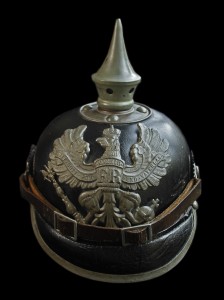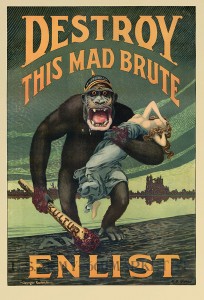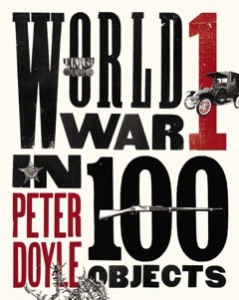By Peter Doyle (Guest Contributor)
 In 1914, all armies were equipped with some form of uniform cap or ceremonial helmet; but it is the German pickelhaube that is the pre-eminent example of the type: gaudy, impractical and affording little protection from either the elements or from shell fragments and bullets. This style of headdress was adopted in 1842, and with its long history, the pickelhaube became a prominent part of the military imagery of the Prussian state, and, later, of Germany itself. The image of the strong German soldier in a spiked helmet was a striking one; with military fashion following the victors spiked helmets emerged at the expense of French-style kepis in the late nineteenth century armies of many countries, the United States included.
In 1914, all armies were equipped with some form of uniform cap or ceremonial helmet; but it is the German pickelhaube that is the pre-eminent example of the type: gaudy, impractical and affording little protection from either the elements or from shell fragments and bullets. This style of headdress was adopted in 1842, and with its long history, the pickelhaube became a prominent part of the military imagery of the Prussian state, and, later, of Germany itself. The image of the strong German soldier in a spiked helmet was a striking one; with military fashion following the victors spiked helmets emerged at the expense of French-style kepis in the late nineteenth century armies of many countries, the United States included.
All-in-all, the helmet was expensive to make, complex and used many important war materials. In an army that grew rapidly, its production was unsustainable. Ersatz or replacement materials were quickly utilized: steel, felt even, to create the complex helmet shell. The example illustrated was introduced in June 1915. Gone were the shiny brass fittings, a metal much in demand to serve the munitions industry. In their place were oxidized steel fittings, cheaper to produce and less visible. The helmet spike was also removable.
 Pickelhaubes helped define the image of the German soldier as an aggressor, particularly with its prominent spike. The alien appearance of the pickelhaube made it the target of Allied propaganda, and the helmet appeared in images intended to invoke national hatred. The spiked headgear was worn by snarling beasts, inhuman ravishers of women and despoilers of Europe’s cultural heritage: political cartoonists such as Louis Raemakers had a field-day with its ungainly image. It was destined to be replaced in 1916 by the Stahlhelm or steel helmet: and with it, fatalities from head wounds declined dramatically. With the passing of the pickelhaube came the birth of industrialized warfare; there was little room for the ceremonial in the killing fields of Flanders, Artois or the Argonne.
Pickelhaubes helped define the image of the German soldier as an aggressor, particularly with its prominent spike. The alien appearance of the pickelhaube made it the target of Allied propaganda, and the helmet appeared in images intended to invoke national hatred. The spiked headgear was worn by snarling beasts, inhuman ravishers of women and despoilers of Europe’s cultural heritage: political cartoonists such as Louis Raemakers had a field-day with its ungainly image. It was destined to be replaced in 1916 by the Stahlhelm or steel helmet: and with it, fatalities from head wounds declined dramatically. With the passing of the pickelhaube came the birth of industrialized warfare; there was little room for the ceremonial in the killing fields of Flanders, Artois or the Argonne.
 Peter Doyle is a military historian and geologist, specializing in battlefield terrain, and the author of World War I in 100 Objects (Plume Books.) He has appeared on television as a contributor on television and in documentaries including WWI Tunnels of Death, The Big Dig, and Battlefield Detectives. He is currently Visiting Professor at University College London.
Peter Doyle is a military historian and geologist, specializing in battlefield terrain, and the author of World War I in 100 Objects (Plume Books.) He has appeared on television as a contributor on television and in documentaries including WWI Tunnels of Death, The Big Dig, and Battlefield Detectives. He is currently Visiting Professor at University College London.
